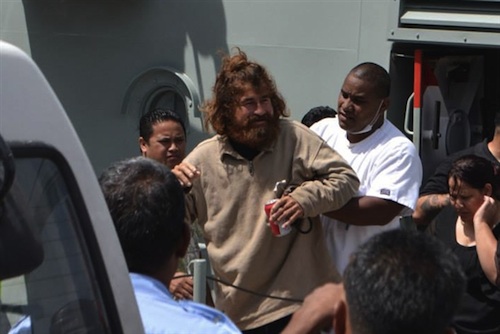I used to read all those Alive books as a kid, because I thought there was a chance I’d be in an avalanche (I’ve never been skiing, in all honesty) or have to save my family from a fire (a small kitchen one, perhaps) or would need to figure out how best to survive on turtle urine while stranded at sea (actually discussed this in seventh grade science for a bit). So when I see stuff like the story of Jose Salvador Alvarenga — who purportedly just floated around for 13 months at sea — I think it’s awesome. Provided, of course, that it’s actually true.
Here’s one cause for concern:
Officials said they have not yet confirmed his account. The man could not recall his own birth date, provided some conflicting information about when he left Mexico, and could not explain why there was no fishing gear on the battered vessel.
Here’s another, from the U.S. Ambassador to the Marshall Islands (where he surfaced):
Ambruster said that while he would expect someone who spent more than a year at sea without supplies to “be in worse shape…there is no alternate explanation at this point for how he wound up there.”
How it started — although the dates are sketchy (could be September or could be December and he could have departed on a Friday or on a Saturday) — was that he was catching sharks on the Mexico/Guatemala border for $1.90 per pound. (As in, that was his vocation.) He left with another man, but within a day or two, the engine died and they began drifting. He was able to keep himself alive this way:
“He talked about scooping up little fish that swam alongside the boat and eating them raw,” Armbruster said. “He also said he ate birds, and drank birds’ blood.”
Unfortunately his friend wasn’t so lucky, and died 3-4 months into the drifting. Jose Salvador Alvarenga threw his body overboard into the Pacific and kept going, with a heavy dose of praying to God for food and assistance.
The total distance between Mexico/Guatemala border and the Marshall Islands is about 5,000 miles. For U.S. context, that’s like drifting, in a boat, from Boston to Los Angeles, then from Los Angeles back to about Ohio/PA.
This has happened before — three Mexicans were rescued after nine months of drifting back in 2006.
So … how long could you really live stranded at sea? It’s kind of contextual — the size of your boat, the area of the ocean, your relative health when the process began, etc. Richard Van Pham survived about four months adrift in the Pacific in 2002, although this current story is about 3-4 times that length. There are a bunch of notable challenges, dehydration and potential sea animal attack being foremost among them. The survival part, then, is hard — especially for over a calendar year. The actual logistics of a boat going from Mexico to the Marshall Islands on a drifting pattern? That’s easier:
Erik van Sebille, a Sydney-based oceanographer at the University of New South Wales, said there was a good chance a boat drifting off Mexico’s west coast would eventually be carried by currents to the Marshall Islands. He said such a journey would typically take 18 months to two years depending on the winds and currents, although 13 months was possible.
“The way that the currents in the Pacific work is that there is a very strong westerly current just north of the equator and that basically drives you directly from Mexico all the way toward Indonesia and in the path, you go right over the Marshall Islands,” he said.
Something does seem a bit odd about his story, specifically the fact that he wasn’t completely and totally emaciated — that said, he could have been eating protein-rich animals, I suppose, and some of the other inconsistencies could be caused by going crazy over 13 months by yourself (including nine months of knowing you disposed of a dead body in the Pacific). If it’s true, it’s obviously one hell of a survival story, kinda like that Nigerian cook story from a few months back:
He basically survived for 72 hours via an air bubble, so the human body is capable of some remarkable things here and there.
If you ever find yourself in this situation — God willing you won’t — here’s some tips. You may have to know how to kill a turtle eventually.
